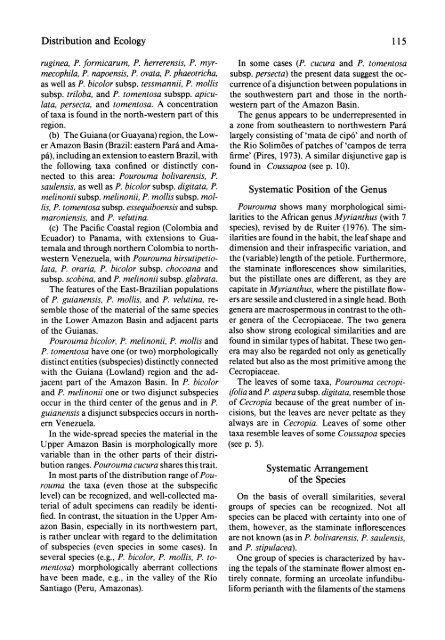Cecropiaceae: Coussapoa and Pourouma, with an ... - CNCFlora
Cecropiaceae: Coussapoa and Pourouma, with an ... - CNCFlora
Cecropiaceae: Coussapoa and Pourouma, with an ... - CNCFlora
You also want an ePaper? Increase the reach of your titles
YUMPU automatically turns print PDFs into web optimized ePapers that Google loves.
Distribution <strong><strong>an</strong>d</strong> Ecology<br />
ruginea, P. formicarum, P. herrerensis, P. myrmecophila,<br />
P. napoensis, P. ovata, P. phaeotricha,<br />
as well as P. bicolor subsp. tessm<strong>an</strong>nii, P. mollis<br />
subsp. triloba, <strong><strong>an</strong>d</strong> P. tomentosa subspp. apiculata,<br />
persecta, <strong><strong>an</strong>d</strong> tomentosa. A concentration<br />
of taxa is found in the north-western part of this<br />
region.<br />
(b) The Gui<strong>an</strong>a (or Guay<strong>an</strong>a) region, the Lower<br />
Amazon Basin (Brazil: eastern Para <strong><strong>an</strong>d</strong> Amapa),<br />
including <strong>an</strong> extension to eastern Brazil, <strong>with</strong><br />
the following taxa confined or distinctly connected<br />
to this area: <strong>Pourouma</strong> bolivarensis, P.<br />
saulensis, as well as P. bicolor subsp. digitata, P.<br />
melinonii subsp. melinonii, P. mollis subsp. mol-<br />
lis, P. tomentosa subsp. essequiboensis <strong><strong>an</strong>d</strong> subsp. <strong>Pourouma</strong> shows m<strong>an</strong>y morphological simimaroniensis,<br />
<strong><strong>an</strong>d</strong> P. velutina.<br />
larities to the Afric<strong>an</strong> genus Myri<strong>an</strong>thus (<strong>with</strong> 7<br />
(c) The Pacific Coastal region (Colombia <strong><strong>an</strong>d</strong> species), revised by de Ruiter (1976). The sim-<br />
Ecuador) to P<strong>an</strong>ama, <strong>with</strong> extensions to Gua- ilarities are found in the habit, the leaf shape <strong><strong>an</strong>d</strong><br />
temala <strong><strong>an</strong>d</strong> through northern Colombia to north- dimension <strong><strong>an</strong>d</strong> their infraspecific variation, <strong><strong>an</strong>d</strong><br />
western Venezuela, <strong>with</strong> <strong>Pourouma</strong> hirsutipetio- the (variable) length of the petiole. Furthermore,<br />
lata, P. oraria, P. bicolor subsp. choco<strong>an</strong>a <strong><strong>an</strong>d</strong> the staminate inflorescences show similarities,<br />
subsp. scobina, <strong><strong>an</strong>d</strong> P. melinonii subsp. glabrata. but the pistillate ones are different, as they are<br />
The features of the East-Brazili<strong>an</strong> populations capitate in Myri<strong>an</strong>thus, where the pistillate flowof<br />
P. gui<strong>an</strong>ensis, P. mollis, <strong><strong>an</strong>d</strong> P. velutina, re- ers are sessile <strong><strong>an</strong>d</strong> clustered in a single head. Both<br />
semble those of the material of the same species genera are macrospermous in contrast to the othin<br />
the Lower Amazon Basin <strong><strong>an</strong>d</strong> adjacent parts er genera of the <strong>Cecropiaceae</strong>. The two genera<br />
of the Gui<strong>an</strong>as.<br />
also show strong ecological similarities <strong><strong>an</strong>d</strong> are<br />
<strong>Pourouma</strong> bicolor, P. melinonii, P. mollis <strong><strong>an</strong>d</strong> found in similar types of habitat. These two gen-<br />
P. tomentosa have one (or two) morphologically era may also be regarded not only as genetically<br />
distinct entities (subspecies) distinctly connected related but also as the most primitive among the<br />
<strong>with</strong> the Gui<strong>an</strong>a (Lowl<strong><strong>an</strong>d</strong>) region <strong><strong>an</strong>d</strong> the ad- <strong>Cecropiaceae</strong>.<br />
jacent part of the Amazon Basin. In P. bicolor The leaves of some taxa, <strong>Pourouma</strong> cecropi<strong><strong>an</strong>d</strong><br />
P. melinonii one or two disjunct subspecies ifolia <strong><strong>an</strong>d</strong> P. aspera subsp. digitata, resemble those<br />
occur in the third center of the genus <strong><strong>an</strong>d</strong> in P. of Cecropia because of the great number of ingui<strong>an</strong>ensis<br />
a disjunct subspecies occurs in north- cisions, but the leaves are never peltate as they<br />
ern Venezuela.<br />
always are in Cecropia. Leaves of some other<br />
In the wide-spread species the material in the taxa resemble leaves of some <strong>Coussapoa</strong> species<br />
Upper Amazon Basin is morphologically more (see p. 5).<br />
variable th<strong>an</strong> in the other parts of their distribution<br />
r<strong>an</strong>ges. <strong>Pourouma</strong> cucura shares this trait.<br />
Systematic<br />
In<br />
Arr<strong>an</strong>gement<br />
most parts of the distribution r<strong>an</strong>ge of Pouof<br />
the<br />
rouma the taxa (even those at the<br />
Species<br />
subspecific<br />
level) c<strong>an</strong> be recognized, <strong><strong>an</strong>d</strong> well-collected ma- On the basis of overall similarities, several<br />
terial of adult specimens c<strong>an</strong> readily be identi- groups of species c<strong>an</strong> be recognized. Not all<br />
fied. In contrast, the situation in the Upper Am- species c<strong>an</strong> be placed <strong>with</strong> certainty into one of<br />
azon Basin, especially in its northwestern part, them, however, as the staminate inflorescences<br />
is rather unclear <strong>with</strong> regard to the delimitation are not known (as in P. bolivarensis, P. saulensis,<br />
of subspecies (even species in some cases). In <strong><strong>an</strong>d</strong> P. stipulacea).<br />
several species (e.g., P. bicolor, P. mollis, P. to- One group of species is characterized by havmentosa)<br />
morphologically aberr<strong>an</strong>t collections ing the tepals of the staminate flower almost enhave<br />
been made, e.g., in the valley of the Rio tirely connate, forming <strong>an</strong> urceolate infundibu-<br />
S<strong>an</strong>tiago (Peru, Amazonas).<br />
liform peri<strong>an</strong>th <strong>with</strong> the filaments of the stamens<br />
115<br />
In some cases (P. cucura <strong><strong>an</strong>d</strong> P. tomentosa<br />
subsp. persecta) the present data suggest the oc-<br />
currence of a disjunction between populations in<br />
the southwestern part <strong><strong>an</strong>d</strong> those in the north-<br />
western part of the Amazon Basin.<br />
The genus appears to be underrepresented in<br />
a zone from southeastern to northwestern Para<br />
largely consisting of'mata de cip6' <strong><strong>an</strong>d</strong> north of<br />
the Rio Solim6es of patches of'campos de terra<br />
firme' (Pires, 1973). A similar disjunctive gap is<br />
found in <strong>Coussapoa</strong> (see p. 10).<br />
Systematic Position of the Genus
















